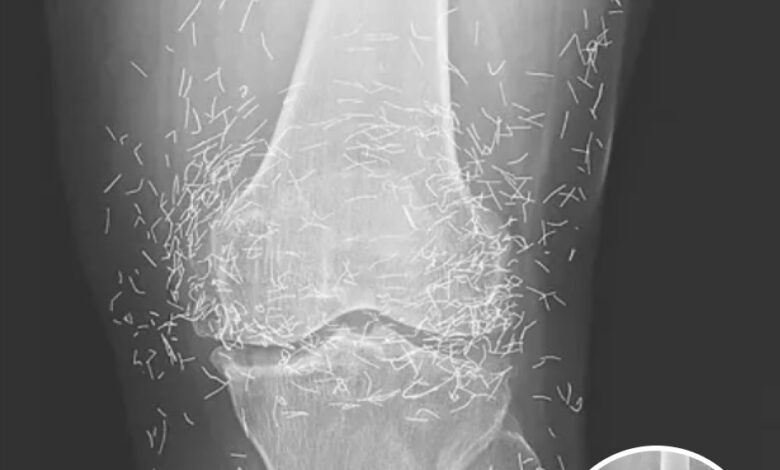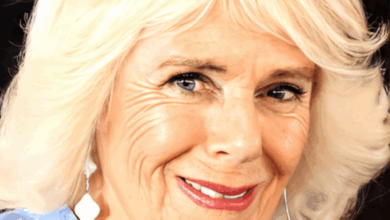
Doctors Stunned After Looking At This X-Ray Of Woman Suffering Joint Pain!
Doctors in South Korea were left stunned when a routine medical examination uncovered something highly unusual inside the knees of a 65-year-old woman. She had been suffering from severe, persistent joint pain, and her condition prompted specialists to order an X-ray. What the images revealed was extraordinary: hundreds of tiny gold needles embedded deep within the tissue around her knees.
The woman had been battling osteoarthritis, a chronic degenerative disease that slowly destroys cartilage and bone inside the joints. For years she endured swelling, stiffness, and the kind of pain that makes everyday activities—walking, bending, climbing stairs—feel like insurmountable challenges. Like many patients, she initially relied on traditional treatments such as prescription painkillers and anti-inflammatory drugs. But while those medications sometimes brought temporary relief, they also led to stomach issues and other side effects that left her searching for an alternative solution.
That search eventually led her to acupuncture, a centuries-old practice deeply rooted in traditional Chinese medicine and widely used across Asia. Acupuncture involves inserting thin, sterile needles into specific points on the body, based on the belief that these points connect with energy channels that influence overall health. Many patients report reduced pain, improved mobility, and relaxation after sessions. For this woman, however, the treatment went far beyond temporary needle insertion.
Her doctors determined that the gold needles had been intentionally left inside her body as part of a long-term treatment plan. Some practitioners in Asia promote this method—implanting gold or other metallic threads under the skin or within muscles—as a way to provide continuous stimulation to problem areas. Supporters believe this offers lasting benefits for conditions like arthritis, especially when conventional medicine falls short.
But not everyone agrees. Experts caution that leaving foreign material inside the body can pose significant health risks. Dr. Ali Guermazi, a professor of radiology at Boston University who was not involved in the woman’s case, explained why the discovery is so concerning. “The human body doesn’t like foreign material,” Guermazi said. “It reacts with defense mechanisms—first through inflammation and later by forming fibrous tissue around the object.” While this scarring process may initially isolate the material, it can also cause pain, stiffness, and even long-term tissue damage.
There are further complications. Retained needles can interfere with medical imaging by obscuring important details in X-rays and CT scans. Even more dangerous, patients with metal fragments in their body face severe risks if they undergo MRI scans. Magnetic resonance imaging relies on strong magnetic fields, which could cause the needles to shift violently, potentially puncturing blood vessels or damaging internal structures. Such a scenario could be life-threatening.
The woman’s case highlights a broader debate about alternative medical practices. Acupuncture remains highly popular, especially in East Asia, and some patients swear by its effectiveness. In South Korea, gold thread implants and permanent acupuncture needles are relatively common for people seeking relief from chronic arthritis. Advocates argue that the metal provides continuous therapeutic benefits. Still, scientific evidence supporting these claims remains limited, and many Western medical experts remain skeptical.
Despite the skepticism, acupuncture has grown steadily in the United States and other Western countries over the past few decades. According to the National Institutes of Health, about 3.1 million American adults and 150,000 children had received acupuncture treatment as of 2007, and the numbers have likely increased since then. Most treatments in the U.S. are temporary—needles are inserted during sessions and removed afterward. Permanent implants, like those found in the South Korean woman, are far less common but not entirely unheard of.
The X-ray images of this case, recently published in the New England Journal of Medicine, serve as a cautionary reminder. While the intentions behind the treatment may have been to provide long-lasting relief, the reality is that the embedded needles introduced new risks that may outweigh the benefits. The woman’s story underscores the importance of carefully weighing potential dangers before turning to extreme or unconventional medical therapies.
Doctors emphasize that while exploring alternative medicine can be valid—especially when conventional methods fail—it is critical to do so under informed guidance and with a clear understanding of the risks involved. Seemingly harmless interventions can sometimes lead to complications that linger for years or create entirely new medical challenges. In this case, a woman searching for relief from painful arthritis instead became the subject of international medical headlines, her knees filled with glittering reminders of a treatment gone too far.
Her experience is not meant to condemn acupuncture as a whole. Many patients do find meaningful relief through careful, professional treatment, and some studies support its value in pain management. But her case does shine a spotlight on the extremes of the practice and the potential dangers of leaving behind foreign objects in the human body. For patients considering such options, her X-ray stands as a sobering lesson: not every alternative therapy is as safe or effective as it appears, and sometimes the promise of relief can conceal hidden risks.




